#gond art deer
Explore tagged Tumblr posts
Text
Thrilling Adventures Beyond the Safari in Kanha: Uncovering Kanha’s Best-Kept Secrets
Thrilling Adventures Beyond the Safari in Kanha offer something more than just tiger sightings. Most people visit Kanha National Park to go on a jungle safari, hoping to spot a tiger. But there’s so much more waiting to be discovered. Hidden meadows, secret trails, tribal villages, and eco-friendly activities are just some of the magical experiences you’ll find beyond the usual tourist route. Located in the heart of Madhya Pradesh, Kanha Tiger Reserve is one of India’s most well-preserved national parks. It is not only rich in wildlife like the Barasingha and leopards but also filled with beautiful scenery, untouched corners, and vibrant local cultures.
Discovering Hidden Trails and Untouched Meadows

While most visitors ride in jeeps hoping to catch a glimpse of a tiger, the real beauty lies in the hidden trails and meadows of Kanha. These are places where you might not see many people, but nature is alive and thriving. One such place is Sonf Meadow, a wide, peaceful grassland where you can spot deer grazing and hear the chirping of many colorful birds. It’s like walking into a painting, with golden grass dancing in the wind and the forest watching silently. Another secret spot is Bamni Dadar, also known as Sunset Point.
Experiencing Tribal Culture and Local Life
One of the most powerful experiences you can have in Kanha is meeting the people who have lived here for generations. The Baiga and Gond tribes are native to this region. They have their own way of life, art, food, and connection with the forest. These communities offer a window into a world that moves at a different rhythm, closer to nature and rich in tradition.
Eco-Friendly Activities and Learning Experiences for All Ages
Kanha is not just a place for adults to go on safaris. It’s also a great spot for families, kids, and students to learn about nature in fun and exciting ways. If you want a travel experience that’s both enjoyable and responsible, there are plenty of eco-friendly activities that let you explore without harming the environment.
Food Trails and Tribal Flavors: A Culinary Adventure
Food is one of the best ways to understand a place. And in Kanha, every meal tells a story. If you’re a food lover, you’re going to love exploring the traditional tribal cuisine that’s deeply rooted in the forest’s culture. The meals you get here are not like typical restaurant food. They are simple, healthy, and made from ingredients grown or gathered locally.
Supporting Wildlife Conservation First-Hand
Kanha is not just a wildlife park—it’s a success story of conservation and care for animals. The park has played a major role in saving the Barasingha, also called the swamp deer, which was once close to extinction. Today, thanks to strong efforts by park officials and conservationists, this majestic deer is thriving once again. One way visitors can help is by learning about these efforts.
0 notes
Text
Animal Art in India: A Cultural and Creative Legacy
India’s artistic heritage is rich, diverse, and deeply rooted in nature—and at its heart lies a profound relationship with animals. From ancient rock shelters to contemporary galleries, animal art in India has served as a mirror of mythology, a symbol of power, and a voice for cultural identity.
This blog takes you on a journey through India’s animal-inspired art traditions, showing how animals have not only been muses, but storytellers of civilization.
A Timeless Beginning: Prehistoric Petroglyphs
The origins of animal art in India can be traced back to prehistoric times, with stunning examples in the Bhimbetka rock shelters in Madhya Pradesh. These 30,000-year-old paintings depict bison, elephants, deer, and other creatures of the wild—testaments to early humans’ dependence on and reverence for animals.
These works, rendered in natural pigments, reflect hunting scenes, animal behaviour, and the beginnings of symbolic expression.
Sacred Symbols in Ancient Temples
Animals are central to Hindu, Buddhist, and Jain art, often appearing in temples as vehicles (vahanas) of gods, symbols of cosmic order, or representations of virtues and vices.
Nandi the bull, the mount of Lord Shiva, stands guard at countless Shaivite temples.
Garuda, the eagle-like mount of Vishnu, symbolizes speed, protection, and divine might.
Elephants, associated with Lord Ganesha, represent wisdom, strength, and auspiciousness.
Lions, found in Buddhist stupas like Sanchi, denote power and guardianship, and famously appear on India’s national emblem.

These animals are not merely decorative; they are alive with narrative—each one a metaphor for cosmic roles and moral messages.
Folk and Tribal Traditions: Living with the Wild
India’s folk and tribal communities have long held a close connection to wildlife, and their art reflects a profound respect for the animal kingdom.
1. Madhubani (Mithila) Art – Bihar
Often featuring elephants, birds, fish, and snakes, Madhubani paintings blend mythology and nature. Animals are drawn in vibrant patterns and filled with symbolic detail.
2. Gond Art – Madhya Pradesh
The Gond tribe sees animals as spiritual beings. Their paintings depict tigers, deer, peacocks, and mythical creatures in stylized, dotted patterns that tell stories of harmony between humans and nature.

3. Warli Art – Maharashtra
Warli painters use basic geometric shapes to depict daily life, where animals like cattle and dogs appear as part of village life and ceremonial processions.
4. Pattachitra – Odisha and West Bengal
This scroll-based art features mythological animals like Gajendra (the divine elephant) and Krishna’s cows, rendered in intricate and graceful detail.

In all these styles, animals are not exotic others, but familiar neighbours, often regarded as divine, ancestral, or moral companions.
Mughal Miniatures: Royal Grace and Natural Study
During the Mughal era, animal painting reached new heights of realism and detail. Court artists under emperors like Akbar and Jahangir documented tigers, cheetahs, elephants, and exotic birds with remarkable accuracy.

These paintings served not only decorative purposes but also scientific and political ones—showcasing the emperor's knowledge of the natural world and his dominion over it.
Mughal miniatures often show animals in courtly hunts, symbolic of power, or as subjects of serene beauty in gardens and wildlife studies.
Contemporary Animal Art: Revival and Awareness
Today, Indian artists continue to explore animal themes, but with modern media and urgent messages. Contemporary animal art in India often addresses:
Wildlife conservation and environmental loss
Urban-animal conflicts
Cultural nostalgia and disappearing traditions
Artists like Baiju Parthan, Bhajju Shyam, and younger wildlife illustrators are reinterpreting traditional animal forms through installations, digital media, and global exhibitions.

Meanwhile, animal figures remain central in Indian crafts—embroidered onto textiles, carved into wood, molded in terracotta, or cast in bronze.
Why Animal Art in India Still Matters
In a country of immense biodiversity and ancient reverence for life, animal art is more than visual expression—it's an ethical and spiritual language.
It connects rural and urban, old and new, sacred and secular. It reminds us that animals are not just part of India's landscape, but its soul—woven into its stories, prayers, and creative pulse.
Final Thoughts
From the timeless elephants of temple carvings to the folk tigers of tribal scrolls, animal art in India is a living tradition, one that evolves with its people while honoring its origins. As India faces ecological challenges, this art becomes both homage and hope—a reminder of coexistence, and a call for compassion.
visit our website and explore variety of artworks by renowned artist's.
https://zigguratss.com
instagram.com/zigguratss
#uy Original Paintings Online Indian Art Pieces Online#Explore Unique Online Paintings#Shop Exclusive Contemporary Art#Buy Original Indian Art Online#Traditional Indian Artwork Store#Modern Art Paintings for Home#Discover Affordable Art Online#Vibrant Canvas Paintings for Sale#Abstract Art Pieces Online India#Authentic Indian Art Prints#High-Quality Oil Paintings India#Watercolor Art Collections Online#Handcrafted Indian Artwork#Online Art Gallery Experience#Folk Art Paintings from India#Captivating Wildlife Paintings#Indian Heritage Art for Sale#Customized Artwork Online#Budget-Friendly Canvas Prints#Exciting Deals on Art Online#Meet Talented Indian Artists#Experience Indian Abstract Art#Serene Landscape Paintings#Exclusive Collections for Home#Artistic Gifts for Every Home#original artwork#paintings#sculptures#original serigraph art#Drawings
0 notes
Text
SEPTEMBER OCTOBER IS THE BEST TIME TO VISIT KANHA NATIONAL PARK
Exploring the Wonders of Kanha National Park: A Perfect Visit in September and October
Introduction Kanha National Park, nestled in the heart of Madhya Pradesh, India, is one of the most celebrated wildlife sanctuaries in the country. Known for its lush landscapes, rich biodiversity, and being the inspiration for Rudyard Kipling’s The Jungle Book, it offers an unforgettable experience to nature lovers and wildlife enthusiasts. Among the best times to explore the magic of this national park is during September and October, right at the cusp of the monsoon retreating and autumn setting in. This blog will walk you through what makes these months ideal for a visit, the experiences awaiting you, and travel tips to make your trip truly remarkable.
Why Visit Kanha National Park in September and October?
1. Pleasant Weather
The rainy season ends in August, leaving behind a refreshing green landscape. With the air feeling cool and crisp, temperatures in September and October typically range between 20°C to 30°C (68°F to 86°F). It’s the perfect time to roam around comfortably without the sweltering heat of summer or the cold of winter.
2. Lush Greenery Post-Monsoon
The monsoon rejuvenates the park, turning the forest into a paradise of emerald foliage. The streams and water bodies are replenished, adding charm to the surroundings. This greenery not only enhances the park’s beauty but also improves your chances of spotting wildlife, as animals gather near water sources.
3. Improved Wildlife Sightings
Although the lush vegetation can sometimes make spotting animals a bit tricky, the abundance of water draws animals out into the open. In these months, you can encounter a variety of creatures such as the Royal Bengal Tiger, Indian Gaur (Bison), leopards, barasingha (swamp deer), and a plethora of bird species.
4. Birdwatcher’s Delight
The transition from the monsoon to winter marks the beginning of birdwatching season. Kanha becomes home to both resident and migratory birds. You can spot birds like the Indian roller, Ma pied hornbill, and several species of eagles and vultures.labar
5. Less Crowded Than Peak Season
While Kanha draws visitors year-round, September and October remain relatively less crowded compared to the peak winter months of November to February. This gives you a more serene experience of the wilderness without the typical tourist rush.
Top Activities to Experience in Kanha
1. Jungle Safari
A jungle safari is a must to explore the deep interiors of the forest. Kanha offers both morning and evening safari rides, allowing you to enjoy wildlife at different times of the day. Jeep safaris are the most popular option, but elephant-back rides are also available for a unique perspective.
Morning Safari Timings: 6:30 AM – 10:30 AM
Evening Safari Timings: 3:00 PM – 6:00 PM
Make sure to book your safari in advance as slots fill up quickly, even in less crowded months.
2. Nature Walks and Birdwatching
If you are an avid birder or prefer a more immersive experience, a guided nature walk is the perfect way to explore the park. With binoculars in hand, you can observe the park’s avian diversity up close.
3. Bamni Dadar – Sunset Point
Known as the sunset point of Kanha, Bamni Dadar offers breathtaking views of the forest bathed in golden hues during sunset. Many herbivores like sambars and gaur can also be spotted in the open grasslands here, making it a scenic spot for photography.
4. Tribal Museum Visit
In addition to wildlife, Kanha offers insights into the local tribal culture. The park is home to the Gond and Baiga tribes, and a visit to the Tribal Museum near the park gate will introduce you to their art, culture, and traditional lifestyle.
Key Wildlife in Kanha
Royal Bengal Tiger: One of the park’s major attractions and the most sought-after species by visitors.
Barasingha (Swamp Deer): Known as the “Jewel of Kanha,” the barasingha is endemic to the park and has been successfully conserved here.
Leopards and Sloth Bears: While more elusive, these creatures offer a thrilling sight when encountered.
Indian Gaur (Bison): The world’s largest wild cattle species, often seen grazing in meadows.
Birdlife: Keep an eye out for kingfishers, serpent eagles, storks, and hornbills during your safaris.
Travel Tips for Visiting Kanha in September and October
Book Safaris and Accommodation in Advance: Although these months are not peak season, planning early ensures you secure the best safari slots and lodging.
What to Wear: Light cotton clothes work well during the day, but carry a light jacket or sweater for early mornings and evenings when it can get chilly.
Carry Binoculars and a Camera: These will enhance your wildlife viewing experience. A DSLR with a good zoom lens is ideal for photography enthusiasts.
Respect Park Rules: Always follow the park’s guidelines to ensure your safety and that of the wildlife. Avoid littering or disturbing animals.
Stay Hydrated and Pack Snacks: While the weather is pleasant, staying hydrated is crucial during safaris. Some snacks can also help keep your energy levels up.
Where to Stay in Kanha
Kanha offers a range of accommodations to suit different budgets and preferences. Some of the popular options include:
Luxury Resorts: Taj Safari Lodge, Kanha Jungle Camp
Mid-Range Hotels: MPT Jungle Resort, Sterling Kanha
Budget-Friendly Options: Kanha Earth Lodge, tribal homestays
Most resorts and lodges are located near the park’s Kisli and Mukki gates. Staying near these entry points makes it easier to access the park for early morning safaris.
How to Reach Kanha National Park
By Air
The nearest airport is in Jabalpur (approximately 170 km away). Other nearby airports include Nagpur (270 km) and Raipur (220 km). From the airport, you can hire a taxi or take a bus to reach the park.
By Train
The closest railway stations are Jabalpur, Gondia, and Bilaspur. Trains from major cities like Delhi, Mumbai, and Kolkata connect to these stations.
By Road
Kanha is well-connected by road to nearby cities like Jabalpur, Nagpur, and Raipur. Regular buses and private taxis are available, making road travel a convenient option.
Conclusion
A trip to Kanha National Park in September and October promises a blend of tranquility, adventure, and natural beauty. Whether you are hoping to spot the elusive tiger, witness the unique barasingha, or simply soak in the serenity of the forest, this park offers it all. The pleasant weather, lush greenery, and relatively low crowds make it an ideal time to visit. With proper planning and a sense of adventure, your journey to Kanha will surely be one to remember.
Pack your bags, book your safari, and get ready to explore the enchanting wilderness of Kanha!
Thank for Read may blog - view more
1 note
·
View note
Text
The Deer Grazing Gond Art Painting beautifully captures the serene essence of nature, featuring a detailed depiction of grazing deer in the traditional Gond art style. Rich in cultural symbolism and vibrant patterns, this handmade piece adds an earthy, artistic charm to your space, celebrating the harmony of wildlife and tribal artistry.
0 notes
Text
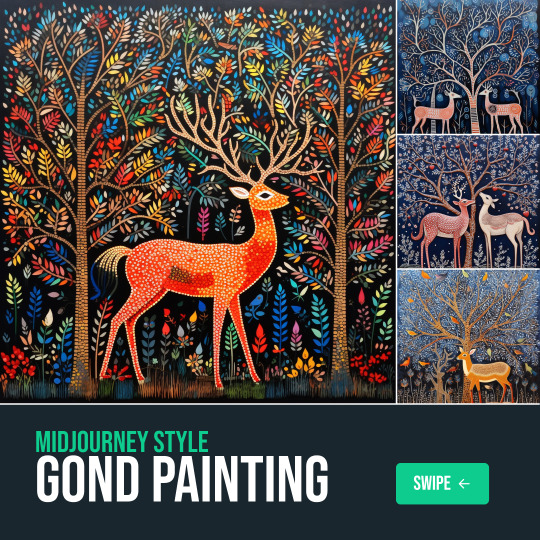
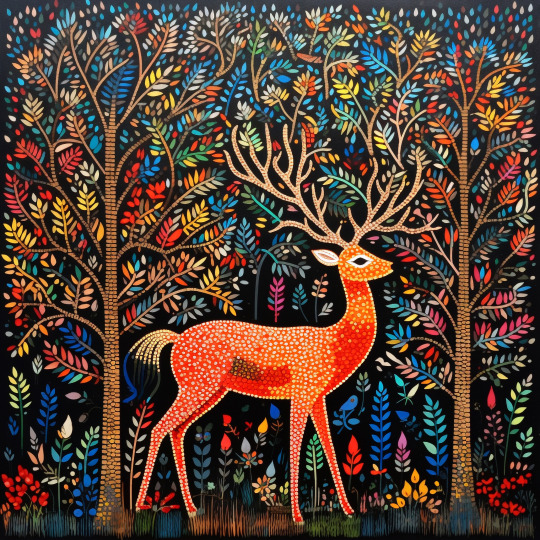
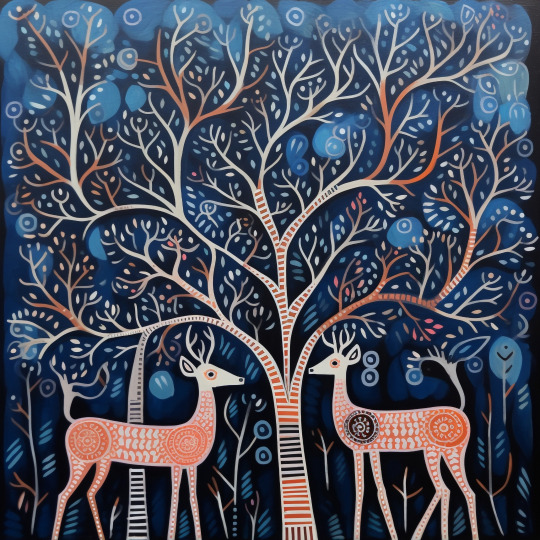
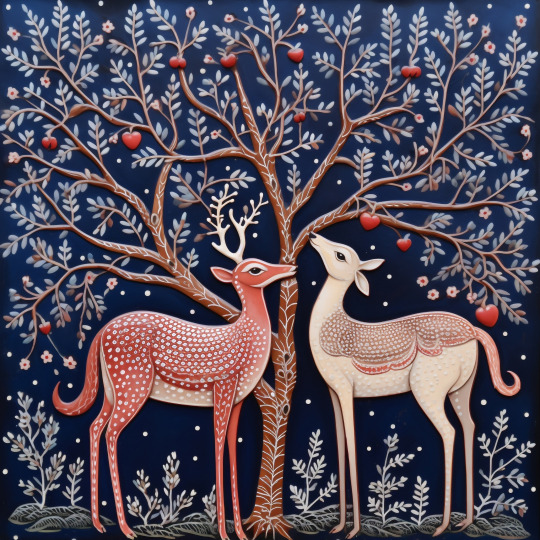
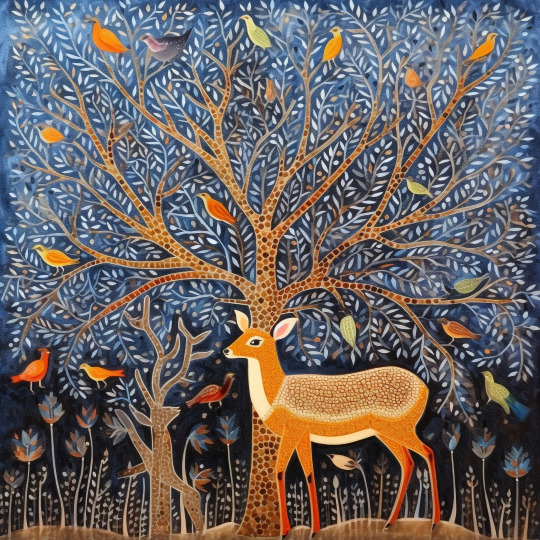
Free Gond Painting Art Style Images
Midjourney Prompt: a deer is painted with different birds and flowers, in the style of gond art, meticulous pointillism --no watermark --ar 110:111
#gondart#gondpainting#indianart#folkart#tribalart#midjourney#imaginebuddy#aiprompt#aistylebuddy#aiimagebuddy#dreambuddy#aiprompts#aiimages#midjourneyprompt#midjourneyaiart#aiart
0 notes
Text
Chhattisgarh: Unveiling the Rich Cultural Heritage and Natural Splendors of Central India
Welcome to Chhattisgarh, a state in central India that unveils a tapestry of rich cultural heritage and natural splendors. Join us as we embark on a journey to explore the diverse landscapes, ancient traditions, and vibrant art forms that make Chhattisgarh a captivating destination.
Chhattisgarh is known for its architectural marvels that date back centuries. One of the most iconic sites is the magnificent Bastar Palace in Jagdalpur, the erstwhile capital of the Bastar kingdom. This palace showcases the unique Bastar architectural style, characterized by intricately carved wooden pillars and vibrant murals depicting local folklore and traditions. Explore the palace complex and immerse yourself in the regal history of the region.
The state is also home to a wealth of ancient temples that reflect the religious and artistic heritage of Chhattisgarh. The Bhoramdeo Temple, often referred to as the “Khajuraho of Chhattisgarh,” is renowned for its intricate carvings and sensuous sculptures. This 11th-century temple dedicated to Lord Shiva stands as a testament to the exquisite craftsmanship of the bygone era. Other notable temples, such as the Danteshwari Temple in Dantewada and the Rajivalochana Temple in Rajim, offer a spiritual retreat amidst serene surroundings.
Chhattisgarh’s tribal communities have preserved their unique traditions and cultural practices over generations. The state is home to a significant population of indigenous tribes, including the Gond, Baiga, and Muria communities. Engage with these communities to learn about their ancient customs, rituals, and art forms. Witness traditional dance forms like Panthi, Raut Nacha, and Karma, which showcase the vibrant folk culture of Chhattisgarh. Explore local markets where tribal artisans display their intricate crafts, such as bamboo and woodwork, tribal jewelry, and colorful textiles.
Nature enthusiasts will be delighted by Chhattisgarh’s abundant natural beauty. The state is blessed with lush forests, picturesque waterfalls, and wildlife sanctuaries. The dense forests of Kanger Valley National Park are home to diverse flora and fauna, including rare species like the Bastar Hill Myna and the Barking Deer. Marvel at the pristine beauty of Chitrakote Falls, often referred to as the “Niagara Falls of India,” as it cascades down amidst a scenic landscape. Visit the Indravati National Park and Udanti-Sitanadi Wildlife Sanctuary to catch glimpses of elusive wildlife, such as tigers, leopards, and elephants.
Chhattisgarh’s cuisine is a gastronomic delight, offering a blend of flavors influenced by the indigenous tribes and neighboring states. Indulge in delectable dishes like the famous Chhattisgarhi red ant chutney, petha (a sweet made from pumpkin), and a variety of traditional millet-based preparations. Don’t miss the opportunity to savor the traditional tribal cuisine, which is characterized by the use of local ingredients and unique cooking techniques.
As you traverse through Chhattisgarh, you’ll witness a seamless blend of ancient traditions and modern development. The state’s vibrant cities, such as Raipur and Bilaspur, showcase modern infrastructure while preserving the essence of Chhattisgarh’s cultural heritage. Visit museums and art galleries to delve deeper into the state’s history, art, and archaeology.
Chhattisgarh, with its rich cultural heritage and natural splendors, invites you to embark on a journey of exploration and discovery. From the architectural wonders to the warm hospitality of the tribal communities, this central Indian state offers a unique blend of experiences.
0 notes
Photo
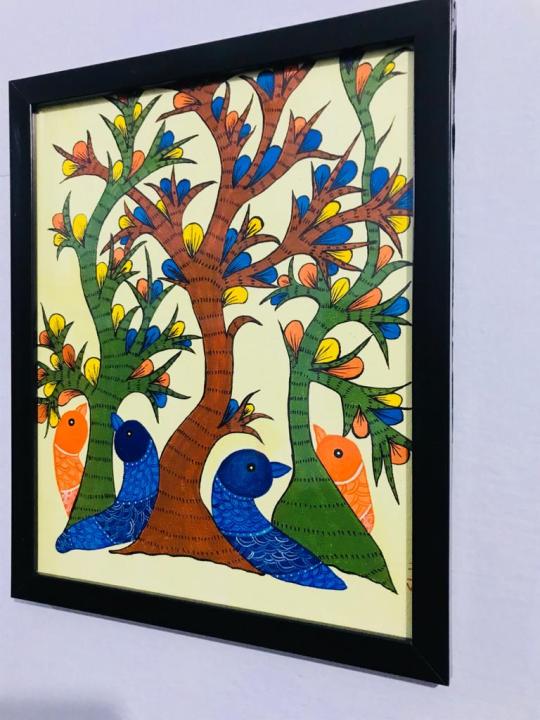
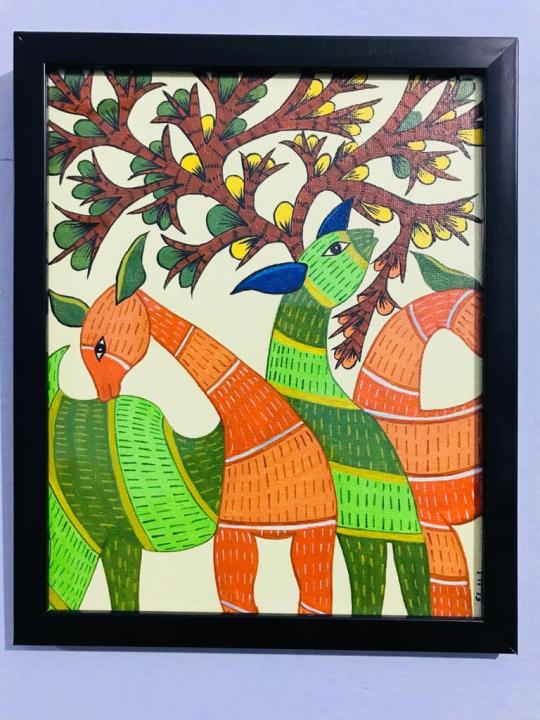
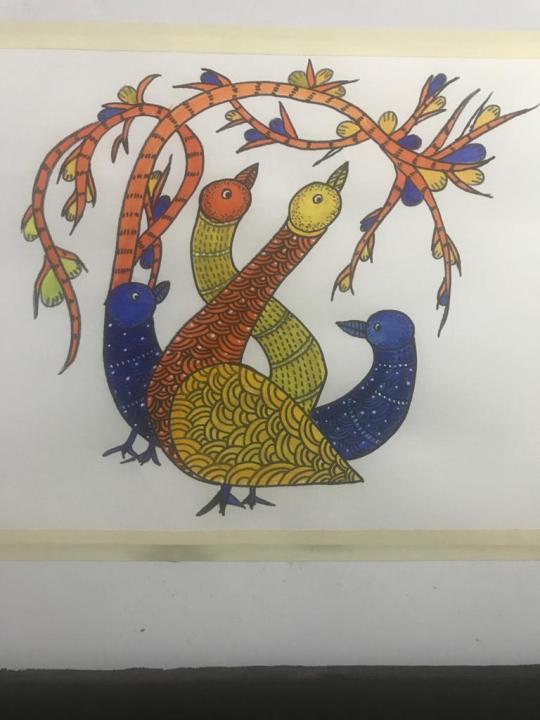
Gond Art paintings
Gond painting price, information, tutorial, images, history and gond art techniques
Today's Gond paintings have become quite popular because of the efforts by the Govt of India to promote and showcase the beauty of tribal art.There have been expo of Gond paintings in many region of the world . Gond paintings price between Rs 3000/- to Rs 50000/-
Today , many talented Gond artists works including Shubhi Jain can be seen on canvases in art galleries internationally.
Shubhi Jain mainly preferred the tree of life surrounded by deer figures .She features different kinds of birds too , while her signature pattern is tree almost erect and still . She takes 3 -21 days to make each painting.
In the eyes of a Gond artist , everything is sanctified and intimately connected to nature . Thus ,the unique oral narrative tradition of the Gond art is reflected in their paintings as well The work of Gond artists is rooted in their culture , and thus story - telling is a strong element of every painting .
However every artist today has a personal style and has developed a specific language within these narratives creating a richness of artfully forms and styles.
Who are Gond Tribes ?
Gond are one of the largest tribes in india and are Dravidian's whose origin can be traced to the pre -Aryan era , who are mainly from Madhya Pradesh and also found in some place of Andhra Pradesh , Maharashtra , Chhattisgarh and Odisha
The word gond comes from kond which means green mountains in the Dravidian idiom. About half of Gonds speak Gondi Languages , While the rest speak Indo - Aryan languages including hindi.
The Gond are also knowns as the Raj Gond The term was widely used in 1950s , but has now become almost obsolete , probably because of the political eclipse of the Gond Rajas. The Gondi language is closely related to Telugu , belonging to the Dravidian family of languages.
The recorded history of the Gond people goes back 1400 years , but considering that they inhabit areas where rock paintings dating to the Mesolithic have been found , their antecedents probably date back even further .
Many of the Gonds customs echo that of their Mesolithic for bearers .An obvious example of this is the custom of embellishing the walls of their houses , an activity that may originate in cave - habitation tradition of their forefathers.
What are the main festivals of Gonds ?
The Gonds paint their walls on festive juncture such as karva Chauth , Diwali , Ashtami , and Nag Panchmi , Gond painting delineate various celebrations ,rituals and man's connection with nature . The artists use natural colors extract from charcoal , colored soil , plant sap , leaves and cow dung .
How is Gond art made ?
Gond paintings can be best be described as 'on line work'. The creator makes sure to draw the inner as well as outer lines with as much care as possible so that the perfection of the lines has an immediate effect on the viewer .
Lines are used in such a way that it conveys a sense of movement to the still images . Dots and dashes are added to impart a greater sense of movement and increase the amount of detail.
In current scenario gond paintings aren't painted on walls and floors and are instead painted on canvas. easy to transport , carry and hang on a wall .
Due to paucity of natural colors in the current age , Gond artists have started to use poster colors .This combined with the use of canvas has made modern Gond paintings much more chromatic than its traditional counter parts.
Gond Art technique tips by artist 'Shubhi Jain'
" Hello art lovers first draw a rough pencil sketch then draw a black outline with use of bright flamboyant colors and with the help of lines, dots and dashes try to create a pattern of design of your own"
" Conventionally , the Gond paintings were done on mud walls with colors elicited from natural materials like soil , charcoal , cow dung and leaves "
" Most important Gond paintings as ' on line work '. Art is created out of carefully draw lines. Lines are used in such a way to convey a sense of movement to still images"
Quote by Gond artist 'Shubhi Jain'
" A painting shows a journey of artist without words"
This blog exclusively sponsored by ' THE NEON ART ACADEMY '
#gondart#gond painting#gond tribe lifestyle#gond art tree#gond art deer#gond art peacock#gond art birds#artsy#ArtGallery#artists on tumblr#ArtMuseum#painting#painter legend
0 notes
Text
Running Deer. Gond art in canvas. To buy visit www.trubalartindia.com or contact +919630226231
https://www.tribalartindia.com
0 notes
Text
Buy the Best Preschool Finger Painting Ideas & Finger Paint Available Here

I was introducing my daughter, Aavya to Indian art.
For Gond art, I prepared this activity which was a mix of some learning and her favourite thing to do- finger paints and thumb painting!
Aavya is a little confused between some lower case letters, so I drew a mommy deer and baby deer with letters "p", "q", "b", "d", "n" and "h"
Gave a colour to each letter, Aavya had to complete the picture by painting the letters to their corresponding colours. When it comes to colours, our choice is always Dabble finger paint
This was also the first time she painted finger painting for preschoolers in restricted lines.
We both had a beautiful time completing this piece of art, we learnt about a different art form, we learnt how mixing 2 colours can give a new colour, we revised lower case letters, we painted using the cool dabble chubby brushes and most importantly we had so much fun With Finger Paint & Hand Painting For Preschoolers time.!
My go to thing to teach her something difficult is involving painting/colouring in it.
Because I believe, if the child is having fun in learning something he/she would easily grasp & Find Preschool Finger Painting Ideas Before.
Actually, Kids very curious about to use Hand Painting For Preschoolers time & Some Preschool Finger Painting Ideas Involve kids to explore a new world.
Dabble PlayArt Provide organic Products to Include Preschool Learning Activity for kids to sharp memory with colors & painting.
Article contributed by Niyati - Homeschooling mom ( Dabbler mom)
Know more about Niyati and her art and learning explorations https://instagram.com/mrs.moonbow?utm_medium=copy_link
So you want to try this,pick up your pack of fun finger painting pack here. Shop Now
#Finger Paint#Preschool Finger Painting Ideas#Hand Painting For Preschoolers#Preschool Learning Activity#finger painting for preschoolers
0 notes
Photo
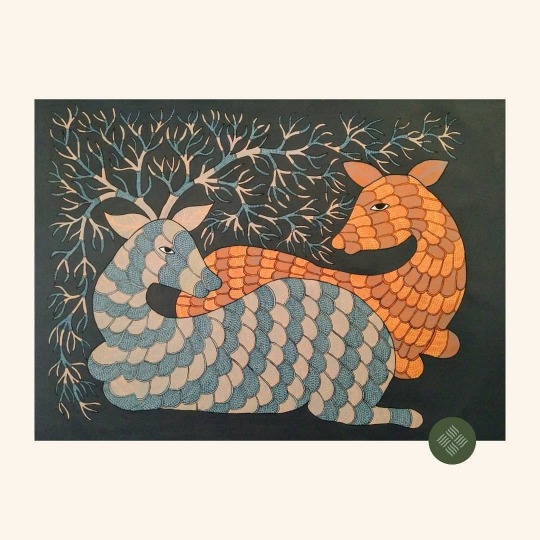
Harmony . Artist: Santoshi Style: Gond Medium: Acrylic on Canvas Size: 36x48 inches Code: 159 . This painting illustrates the harmonious union of the old souls of deer. Resting comfortably in the lap of nature they display contented emotions in the present moment which creates a delightful resonance in a vast expanse of the universe. The artist has been mentored and encouraged to use new design concepts and color palette in Gond art form, creating unique artworks. . Painting from the series of The Gondwana Art Project - a social initiative to up-skill tribal artisans from Central India . #gondart #gondpainting #tribalart #tribalartists #traditionalart #crafts #folkartist #folkart #ccdfindia #gondwanaartproject #nativeart #indiaartfair #aboriginalart #authenticart #artsofindia #tribalpattern #sundeepbhandari #gondwana #interiordesign #craftcurate #artandcraft #creativity #nftart #artoftheday #nftartist #designcollection #graphicdesign https://www.instagram.com/p/CQd_ppDJYgE/?utm_medium=tumblr
#gondart#gondpainting#tribalart#tribalartists#traditionalart#crafts#folkartist#folkart#ccdfindia#gondwanaartproject#nativeart#indiaartfair#aboriginalart#authenticart#artsofindia#tribalpattern#sundeepbhandari#gondwana#interiordesign#craftcurate#artandcraft#creativity#nftart#artoftheday#nftartist#designcollection#graphicdesign
0 notes
Photo

What are aspects of a good relationship? I think they must include balance, support, and an ability to compromise. I was reading about this striking #artwalklittleindia piece and this is a representation of such a beautiful relationship. Bhajju Shyam and Singaporean artist Sam Lo virtually collaborated to create “Dancing in Unison”. The mural is meant to symbolize the balance and relationship between urban and natural elements. The tree takes over the urban environment (the building and its windows) which becomes a metaphor for the universe where everything is interconnected from the land to the air. Elements from Gond art (the tree and deer) marry with the ever present Singaporean swallows. #exploresingapore #explorelocal (at Little India) https://www.instagram.com/p/CNFd5gegRo9/?igshid=19wiioquv69pc
0 notes
Text
Q&A with Pascale Petit

M: There is a family narrative that runs through the collection, as well as the underlying theme of environmental catastrophe and extinction. Can you speak to how these two concerns parallel or amplify each other? P: I write intuitively, guided by images, the song of the line, its dynamic, and by my excitement towards the subject. The draft has to feel true. When I write well, I am playing with all these elements, it’s a serious play, but I am in a childlike tranced state. The themes that emerge in the book appear almost as a by-product – they don’t lead it.
Tiger Girl reveals the cruelty of human beings in their treatment of non-human life, and each other. If I look back on my books, I suspect that most of them are asking this question: are humans essentially good or bad? Perhaps that’s why I’m driven to examine the way that people in power treat the powerless. I’ve tended to do this by holding a magnifying glass to my dysfunctional family, in particular on my parents and difficult childhood. In Tiger Girl I focus on the benevolence of my Indian grandmother, who took me in as a baby, then later, from the age of seven until fourteen. She didn’t have to do that, so in Tiger Girl she is a force for good, and the book is in a way a series of grandmother love poems. She is this saviour, who herself was saved. Her origins are a mystery, but I’ve been told that in Rajasthan where she was born, she was taken in by her father’s white family, while her real mother was the maid. I wanted to explore her heritage, her country, but most of all – I wanted to see a wild tiger as she had done as an infant, when one walked into her tent. So, I went to India to experience the wildlife, and fell in love with it; the national parks are brimming with animals and birds!
Going into the tiger forests in open jeeps is addictive! I’d wake at four, and be at the forest gate by five, waiting for it to open. Then the rush to find tracks, to catch a tigress patrolling her realm, the theatre of alarm calls that we’d be in the centre of, a sensurround of barks started by langurs at their treetop lookouts, and taken up by the deer. The tiger hidden, but there! But I soon realised what an immense struggle it is to keep the tigers alive, as well as all the other fauna – elephants, sloth bears, mongooses, owls and Indian rollers. Poaching is a constant threat. The parallel with my family story – how my grandmother was saved by her father, how I was saved by her from more years in an orphanage, and from the “poaching” of my parents on my body and soul, is a testimony to kindness and love. It’s kindness, love and empathy for wild animals that can save them from cruelty and abuse. We only have to empathise with them to know they suffer, and to stop the suffering. The situation in India is complicated, as in many wild parts of the world, by poverty. I’ve heard and read accounts by poachers who became forest guards, who went on to protect the tigers they once poached. Their guard-work is informed by their poaching experience; they know when and where incursions into the forest will occur. But what struck me was the indifference one guard divulged in his former life as a poacher. My account of his poaching methods is recorded in my long poem ‘In the Forest’. He needed the money for food. His need killed his empathy, his victim was just a means to make money, not a companion suffering being. The animal/human predicament echoes the dynamic between a person with power (such as a parent or president) and the powerless. M: That makes a good deal of sense given how I read the book, one image layering over the next in an intuitive, almost subconscious way. What was your revision process like, and how did you determine the arc of the book? P: I started writing Tiger Girl just after the Brexit referendum. My anxieties about citizenship and possible expulsion – I eventually applied and got British citizenship – reminded me of my grandmother’s situation, and how she’d had to conceal the fact that she was Indian. I hadn’t been aware of it when I lived with her as a child. All I could really remember were certain mysteries, her tiger stories, her speaking Hindi in her sleep. I started researching where tigers were in India, and read every tiger book I could find. I planned my first trip to Ranthambore National Park in Rajasthan, followed by Kanha and Bandhavgarh National Parks in Madhya Pradesh, the tiger heartland. I went over twice, and would have gone more, but Covid-19 happened. I had no idea there’d be so many animals and birds – imagine discovering your heaven then realising it is under threat of vanishing. This is the situation we find ourselves in on this planet: the wild is a place of awe and wonder, but it’s vanishing even as we discover new species. So, what set out to be a personal quest for identity and heritage, became a story about the forests and their fauna. Of course, now, because of Covid-19, there are new threats to wildlife, not least because it’s a zoonotic virus that it is thought originated in bats, passed through a mammal such as the much-poached and probably soon-extinct pangolin, to humans. My personal experience of cruelty at the hands of parents gave me empathy with the animals that are tortured and killed. Are they the childhood of the planet? I’m terrified that we will end up as the only large mammals on Earth, our companions gone, their homes destroyed. It’s unbearable to imagine a world without forests or animals, so, throughout Tiger Girl, there are flashes of hope, clearings with sunlit birds or rare deer. There is also fire threaded through, simmering in the first poem ‘Her Gypsy Clothes’, becoming a roar in the final poem ‘Walking Fire’. None of this was planned, but as I was finishing the manuscript one year ago, our world seemed to be on fire, from California to the Amazon, to New South Wales.
My revision process varied wildly, some poems wrote themselves whole, especially ‘In the Forest’ and ‘Green Bee-eater’. Others needed many recasts. With ‘The Anthropocene’, I had the moving image of the planet as a bride wearing a peacock dress as soon as I saw the news items of the Chinese bride in hers. The image wouldn’t let me be, so those lines hovered on my desktop. But the song of the poem came later, after I’d read The Night Life of Trees from Tara Books, featuring art of the tribal forest artists, the Gond from Madhya Pradesh. I kept looking at the trees they’d printed, and reading the captions from their beliefs. One tree is called ‘The Peacock’, and the caption said “when the peacock dances in the forest, everything watches, and the trees change their form to turn into flaming feathers”. And that gave me my song. The stepped form on the page felt right and might suggest a bride’s train or poised waves. There was a particularly violent hurricane season last year as I was drafting it, so that became the theme, of climate change.
M: As someone who writes about animals--and who is enamored with them--I share your pain and terror at the thought of a future without them. How do you see the poems in Tiger Girl speaking to the poems in Mama Amazonica?
P: Tiger Girl features my grandmother and her tiger childhood, and Mama Amazonica is a portrait of my mentally ill mother as the Amazon rainforest. These two women hardly spoke to each other in the last years of their lives; they are in many ways opposites.
Both books juxtapose a family in crisis with the natural world in crisis, and link abuse of women and children with abuse of animals and forests. But I don’t set out to do this, it’s what the poems reveal. If I take the central poem of Tiger Girl, which is for me ‘In the Forest’, and compare it to the central poem of Mama Amazonica, which for me is ‘My Amazonian Birth’, Mama Amazonica is more hopeful of a human’s rebirth in the pristine rainforest, even if that rainforest is sick and broken. What happened between the writing of the two books was Trump’s increasingly anti-eco politics and the rise to power of Bolsonaro in Brazil, followed by the election of Boris Johnson in the UK and a general global rise of fascism and contempt for the natural world. Yet, the personal story in Tiger Girl, of my Indian grandmother saving me from my abusive parents, is hopeful. And there are splashes of hope throughout the book. There has to be hope. The human psychodrama is hopeful, because what my grandmother did, taking me in for two years as a baby, then for seven years as a child, passed her strong spirit on to me and supported me all my life. Yet, even there, there is betrayal, the story of her returning me to my mother, twice, while Mama Amazonica is both my abused and mentally ill mother, and the abused mother-forest. The human drama mirrors the drama that’s unfolding on our planet – a struggle for the oppressed wild to survive. In India, that struggle is an old one, where the plenitude of charismatic megafauna is in conflict with the dense human population and poverty. The only relatively safe forests are in national parks, yet even there, there is poaching. As for my writing journey – the ‘tiger girl’ of my Indian grandmother is a character I’ve rarely written about before, though it is she who opens my very first collection Heart of a Deer, published in 1998, with the poem ‘Mirador’, that also tells the story of her death on fireworks night. In Tiger Girl I wanted to explore her spirit, how nourishing the older woman figure was, who appeared “like a goddess to me”.
M: Are there any particular texts or works of art with which you feel the book is in conversation?
P: Tiger Girl is mainly in conversation with two artists. As I began writing the book, I discovered installations by the Chinese artist Cai Guo-Qiang, and felt very excited by them. I was first attracted to his work because of his installation Inopportune: Stage Two, of nine life-size replicas of tigers leaping through the air, shot and transfixed mid-leap by bamboo arrows. I almost felt at this stage that his work would dominate the book. I wanted to write my equivalents of his firework events. In the end, only two poems remained in my final cut: Ethereal Flowers, which I turned into ‘Her Flowers’, and Sky Ladder, which became my ‘Sky Ladder’. That he worked with gunpowder and fireworks and a ladder made of fireworks that explodes into the sky, felt a direct link to my grandmother’s death on Guy Fawkes night. I watched his film Sky Ladder, and my poem came out of the way he dedicated the event to his 100-year-old granny. The second main artist Tiger Girl is in conversation with is the late Pardhan Gond painter Jangarh Singh Shyam, founder of Gond art, whose tribe know the Central Indian forest secrets. Like him, I’m obsessed with deer and their antlers and how antlers mirror a forest. He died tragically early, but I wanted to honour him, so I wrote a poem for him, ‘Barasingha’, about the endangered twelve-tined swamp deer and how his life was changed after coming face to face with one. My cover art The friendship of the tiger and the boar is by him and I love how my publisher Bloodaxe has wrapped the Gond tree around the back cover. As well as these two artists, a poem early in the book, ‘Surprised!’ is a response to Henri Rousseau’s painting, Surprised! (Tiger in a Tropical Storm) – I love his work! Other poems, such as ‘The Umbrella Stand’, were influenced by Jim Corbett’s tiger hunting books. William Blake hovers in the background of ‘In the Forest’ and ‘Wild Dogs’. ‘For a Coming Extinction’ is a response to the same titled poem by W. S. Merwin. In the poem ‘Her Staircase’, I managed to write about my grandmother’s fatal staircase through a re-imagining of the installation Staircase III, by the Korean artist Do Ho Suh, which I’d spent hours sitting beneath while tutoring poetry courses at Tate Modern. Two poems are even dedicated to my first love John Keats and his forested worlds.
0 notes
Text
This Birds with Deer Gond Art Painting beautifully captures the harmony of nature, showcasing vibrant birds perched alongside a graceful deer in the distinctive Gond art style. With its intricate patterns and earthy tones, this handmade piece adds a touch of traditional elegance to any space, celebrating the deep connection between wildlife and tribal folklore.
0 notes
Video
Autumn in the valley by Katarina Stefanović Via Flickr: You can follow me also on Getty | 500 px | Deviant Art Derborence is a hamlet in the municipality of Conthey, in the canton of Valais, in Switzerland. It is located at 1,450 metres in an isolated valley on the south side of the Bernese Alps and is not permanently inhabited. Derborence is completely surrounded by mountains: The Diablerets (highest) on the north, Haut de Cry on the south and Mont Gond on the east. Lake Derborence was formed in 1749 after two landslides coming from the south wall of the Diablerets. Thousands of tons of rock came crashing down from a height of 1900 metres in 1714 and 1749, coming to 400 metres below and forming a 2 kilometre-long natural barrier which gradually filled with water. A virgin forest grew on the rock debris. It consists of spruce, pine, larch, stone pine, beech and willows. The area was acquired by Pro Natura in 1961 and is now protected. The valley, which is exceptionnaly rich in fauna, is a natural habitat for ibex, chamois, deer, marmots and hares and several bird species including the owl, golden eagle, bearded vulture and alpine chough. en.wikipedia.org/wiki/Derborence The Alps (French: Alpes; German: Alpen; Italian: Alpi; Romansh: Alps; Slovene: Alpe) is the name for one of the great mountain range systems of Europe, stretching from Austria and Slovenia in the east, through Italy, Switzerland, Liechtenstein and Germany to France in the west. The word “Alps” was taken via French from Latin Alpes (meaning “the Alps”), which may be influenced by the Latin words albus (white) or altus (high) or more likely a Latin rendering of a Celtic or Ligurian original. The highest mountain in the Alps is Mont Blanc, at 4,808 metres (15,774 ft), on the Italian-French border. All the main peaks of the Alps can be found in the list of mountains of the Alps and list of Alpine peaks by prominence. The Alps are generally divided into the Western Alps and the Eastern Alps. The division is along the line between Lake Constance and Lake Como, following the Rhine. The Western Alps are higher, but their central chain is shorter and curved; they are located in Italy, France and Switzerland. The Eastern Alps (main ridge system elongated and broad) belong to Austria, Germany, Italy, Liechtenstein, Slovenia and Switzerland. The Alps are a classic example of what happens when a temperate area at lower altitude gives way to higher elevation terrain. Elevations around the world which have cold climates similar to those found in polar areas have been called alpine. A rise from sea level into the upper regions of the atmosphere causes the temperature to decrease. The effect of mountain chains on prevailing winds is to carry warm air belonging to the lower region into an upper zone, where it expands in volume at the cost of a proportionate loss of heat, often accompanied by the precipitation of moisture in the form of snow or rain. en.wikipedia.org/wiki/Alps
#landscape#paisaje#nature#autumn#mountain#hills#fields#valley#getty license#trees#travel#nikon#vacation#switzerland#swiss#europe#europa#fog#mist#katarina2353#light#sion#derborance#valais#derborence#levels#shadows#place#view#day
1 note
·
View note
Text
Self-sufficiency and a better future for rural women in India
At The Elephant Head, we continue our efforts to feature goods that we love, ones that are handcrafted using traditional techniques, handmade by independent, small-scale artisan groups, and ones that support sustainable working practices. Our recent partnership with Indian charity, Aham Bhumika is another step in this direction.
The beautiful range of hand embroidered charity-made cushion covers on sale on our website have proven to be quite popular, with only a few products left in stock. Each cushion cover has been hand-embroidered by an artisan from a village on the outskirts of Bhopal, India, as part of The Embroidery Project, an Aham Bhumika initiative.
Based in Bhopal in Madhya Pradesh in India, Aham Bhumika is a Non-Government Organisation that works to equip underprivileged women living in rural areas with the skills they need to earn a living and become self-sufficient. So far, The Embroidery Project has taught more than 30 women how to create products such as sarees, tote bags and cushion covers which they can then sell to generate an income.
Quirky, fun, sophisticated… something for everyone!
Ten different designs are available to choose from, and there’s something for everyone, from the fun, the quirky, and the vibrant, to the sophisticated, charming and elegant. Each square cushion cover measures 16 X 16 inches, is made from cotton and has a tie-back fastening so it can be removed from the cushion for washing. The quality and attention to detail on each cover make them a wonderful and unique addition to any home, or business.
Many of the designs on the cushion covers are inspired by Gond art, a tribal art form of Central India. The Gonds, are the largest tribal (Adivasi) community in India and are Dravidian's whose origin can be traced to the pre-Aryan era. The word Gond comes from Kond, which means green mountains in the Dravidian idiom. Read more about the contemporary evolution of this art form.
Gond art is particularly evident in the Gond Deer cushion (£19.50), a whimsical pink deer with sprawling antlers, and The Turbaned Indian Man (£19.50), who is certain to evoke a smile. The Turbaned Indian Man is inspired by a Kisan, a stereotypical, bidi-smoking farmer with a big turban and exaggerated moustache.
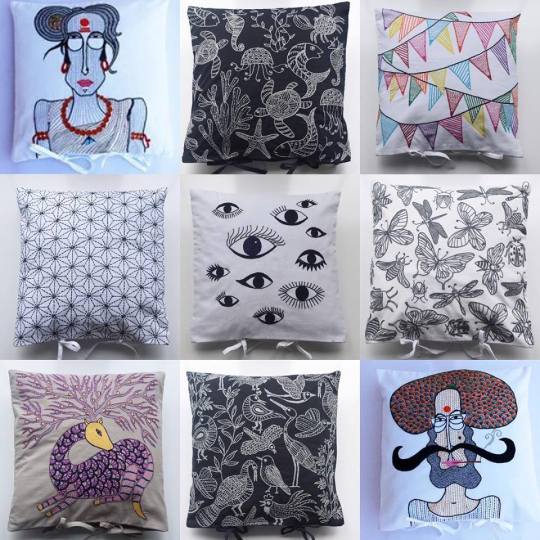
Other designs include delightful Bugs and Butterflies (£17.50), Colourful Bunting (£16.50), the slightly mystical Birds (£17.50) and Sea Creatures (£17.50) and the quirky Eyes cushion (£16.50).
For those who prefer monochrome or geometrical patterns, the Circular Patterned Cushion (£16.50) and Geometric Cushion Cover (£16.50) are inspired by Sashiko, a form of Japanese folk embroidery.
Shop for a cause
When you purchase an Aham Bhumika cushion cover from The Elephant Head, you not only benefit from a quality cushion that has been pre-shrunk and pre-washed for your convenience but is also helping to fund this incredibly worthwhile organisation.
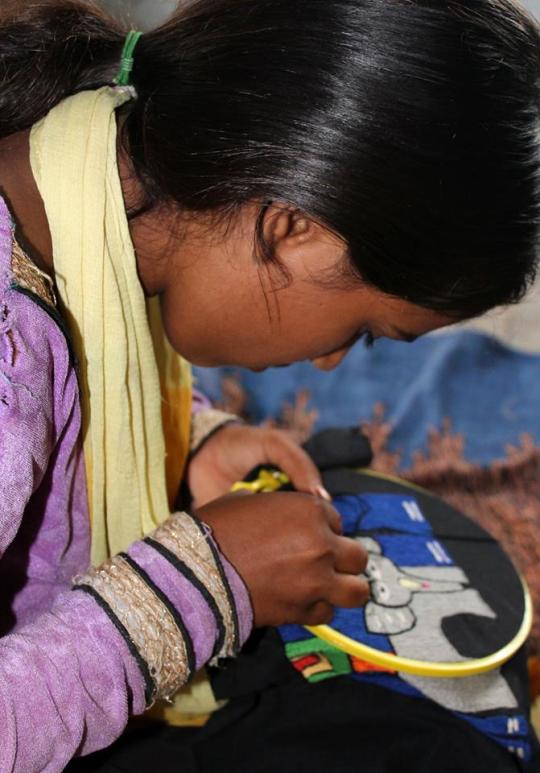
Shop this collection>
#handmade#cushions#charity#charitymade#cushioncover#onlinestore#onlineshopping#madeinindia#ruralwomen#handembroidery
0 notes
Text
5 Prominent Indian States Well-Known for their Customs & Costumes
India’s rich cultural diversity is probably the greatest gift that God has ever given to mankind. Accurately mirrored in a vast spectrum of customs and costumes, India’s rich heritage has been aptly visualized by the bard and Nobel laureate Rabindranath Tagore in these lines extracted from his poem “Dispenser of the Destiny of India”, the first stanza of which has been adopted as India’s national anthem:
“We heed to your gracious call The Hindus, Buddhists, Sikhs, Jains, Parsis, Muslims and Christians, The East and the West come together, to the side of your throne And weave the garland of love.”
Standing in the 21st century if one had to inhale the beauty of India’s diversity in one breath, he shall have a Himalayan task at hand. With so much to see, feel and experience, it is advisable to explore it in the costumes and cultures of places located in these five different Indian states, each of which is unique in terms of its ethnic wear, festivities and traditions.
Leh-Ladakh: Frozen in Time and Rooted in Tibetan Buddhist Traditions
Photo: https://goo.gl/Q9pr4d
The crowning jewel of India, Leh-Ladakh, located in the state of Jammu & Kashmir, makes time stand still in the frozen and arid landscape of the Himalayas. The biting cold of the region, heavy snowfall, sporadic cloud bursts and snow caped mountains leave their imprint on the ethnic dress code of the local inhabitants of Ladakh. Men sport the traditional thick woollen robe called the “Goucha” that is fastened at the neck and tied at the waist with a sash called the “Skerag”. Women wear a similar robe called the “Kuntop” and sport a shawl on their back called the “Bok” that allows them to carry a baby or essentials of daily chores. Women in Ladakh also wear a traditional hat made of Yak wool or leather called the “Perak”. The “Perak” has three, five, seven or nine streaks of colours, depending upon the social standing of the incumbent. Nick named the Last Shangrila and also the Little Tibet, Leh-Ladakh has strong imprints of Tibetan Buddhism. A major festival is the Hemis, celebrated on the tenth day of the lunar calendar of the Tibetan month to commemorate the birth anniversary of Padmasambhava, the Buddhist monk that along with BhikhuShankarakshita is credited with establishing Buddhism in Leh-Ladakh in the eighth century.
[ Book Hand-Tailored Tour Packages to Leh-Ladakh at Best Price ]
Arunachal Pradesh: The Land of the Rising Sun in India
Photo: https://goo.gl/YbqBQC
From Leh-Ladakh in the north, the garland of Himalayas stretches to the far end of the north eastern region of India. Arunachal Pradesh, known as the land of the rising sun in India is the home to 26 different ethnic tribes and 100 sub-tribes. Each tribe in Arunachal Pradesh follows a unique dress code that is rooted in its folklore, mythology and culture. As on today, major tribes in Arunachal Pradesh include the Adi, Aka, Galo, Nyishi, Apatani, Sherdukpen, Bori, Tagnis, Miji and Bokar. The Apatani tribes use fibres from trees, goats, yaks, deer, bear and human hair to create strikingly beautiful coats, shawls, skirts, sashes and loin clothes that are embellished with various forms of embroidery work. Among other major tribes the Sherdukpen males wear sleeveless silk material of knee length with edges attached to shoulders, while the women wear sleeveless dresses till knee length with a full embroidery jacket. The West Kameng and Tawang districts of Arunachal Pradesh are highly influenced by Tibetan Buddhism. The fourteenth Dalai Lama was born in Tawang. Festivals like the Torgya celebrated on the 28th day of the 11th month of the lunar calendar at the Tawang monastery draw thousands of visitors from India, Western Europe and South East Asia. The bonfire offering of Torma to bonfire symbolizes the destruction of all evil.
[ Book Customized Holiday Tour Packages to Arunachal Pradesh ]
Rajasthan: Sagas of Steel and Sand Soaked in Royalty
Photo: https://goo.gl/dssoch
If there is any place on earth where arid sands narrate a history of valour, chauvinism and pride, it is Rajasthan. The people of Rajasthan led by the local martial race of the Rajputs love their culture, language, music and costumes. The bright colours, designs and embroideries of Rajasthani costumes are an instant hit with travellers from foreign lands. Male attire in Rajasthan consists of turbans, dhoti or pyjama and a kurta. Turbans worn by people offer an insight into their social standing and ethnic origin. People from Udaipur wear flat turbans, while those from Jaipur sport angular turbans with curved bands. Men born into the warrior caste of Kshatriya wear an Angarakha made up of cotton and can portray either a frock style or waist length. The attire of women in Rajasthan consists of a Ghaghara; an ankle length long skirt with narrow waist. Common print styles of the Ghaghara include laharia, mothra and chunari and popular colour codes include red, maroon and dark pink dotted with streaks and dots of yellow. The look becomes complete with shoes called the Jooti made of sheep, camel or goat skin. On festive occasions like Dhulandi, Diwali, Holi or the famous camel fair in Pushkar, men wear silk dhotis with a Zari border. It is customary for women in Rajasthan to wear bangles that cover their entire hands.
Also Read: Most Famous Tourist Getaways in Rajasthan
Chhattisgarh: Baptized in the Name of Thirty Six Forts
Photo: https://goo.gl/F5EaGv
Chhattisgarh derives its name from a legend that there once existed thirty six forts in the period leading to the British Raj. The proximity of Chhattisgarh to Jharkhand and Odisha on the east and Maharashtra on the west means that the state lies in the tribal inhabited stretch of India endowed with the riches of minerals, mined and metals along with a beautiful lush green and dense forest cover. Chhattisgarh is the home of tribes who are the indigenous colors of India such as Gond, Korba, Baiga, Bison Horn Maria, Abhuj Maria and Muria that stay in and protect the natural endowments in the forest areas. Gonds; the major community in the state are known for their unique Ghotul system of marriage and tribal dance forms like the Salai, Suwa and Karma. All tribes of Chattisgarh are proud of their heritage and carry their costumes as symbols of tribal legacy. Both men and women love to wear bright and colourful ethnic tribal attire. A major highlight of tribal wear is jewellery made of metal casts, silver templates and wood. Tribal men wear dhotis made of cotton and linen and top it with head gear that reflects tribal design styles. Tribal women in Chhattisgarh wear silk, linen or cotton saris of knee length that are painted in bright colours with molten wax, called Kosa silk or the lost wax art.
Also Read: Popular Tourist Attraction to Visit on Your Chhattisgarh Holiday Trip
Kerala: Backwaters, Houseboats and Ayurveda; Chicken Soup for the Soul
Photo: https://goo.gl/RfAjFE
Legend has it that Lord Parasurama had recovered Kerala from beneath the seas by throwing his axe to force back the waters. Consequently, Kerala is also called Parasurama Kshteram. There is a certain alluring charm in the natural beauty of Kerala and the natural healing powers of Ayurveda. In fact Kerala is the birthplace of the age-old science of Ayurveda and the amazing tranquillity in its lush green environment augments the recovery of patients from ailments. The lazy elegance of houseboats gliding on the backwaters in Kerala, the ancient temples and a colourful festive calendar dotted with Onam, Vishu and Theyyam and the historical places and monuments that narrate the confluence of the native Syrian Christians, the Malabar Muslims and Dravidian Hindus aptly justify the rationale behind people from across the world lavishing praise on the visual treat in the God’s own country. The fact that white colour defines the most common colour code of the attires of both men and women, only reflects the peaceful ambience of Kerala. Women in Kerala dressed in the local Mundum Neriyathum, a two piece cloth worn around the waist, embellished with a golden border called Kara symbolize the simplicity of Kerala’s culture, except for special occasions like Onam when they wear heavy gold jewellery while breaking into the traditional Kalkotti Kalli dance.
Men in Kerala bear a conservative streak in their dress code and are seen wearing the Kasavu Mundu, made of cotton with a silk border for both daily work and festivities.
[ Check Out Best Deals on Kerala Holiday Tour Packages ]
From the Kerala backwaters in down south, the endowment rich vegetation of Chhattisgarh, the red sand stone built environment of Rajputs in Rajasthan, the tribal heartland of Arunachal Pradesh that is blessed with first rays of the sun every day in India to the timeless Buddhist bliss in snow-capped mountains of Leh Ladakh, India showcases diversity in form and content like no other nation in the world. Each different culture, costume and topography is one of the many colours in the rainbow called India.
The post 5 Prominent Indian States Well-Known for their Customs & Costumes appeared first on Tour My India.
from Tour My India
0 notes
